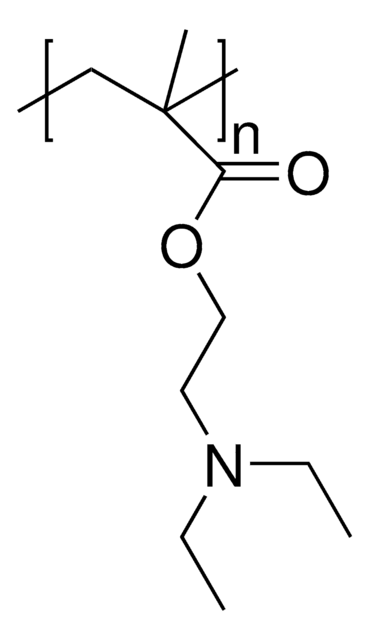909866
Poly(2-(dimethylamino)ethyl methacrylate)
average Mn 10,000
Sinonimo/i:
Hydrophilic polymer, PDMAEMA, pH sensitive, pH-responsive
Autenticatiper visualizzare i prezzi riservati alla tua organizzazione & contrattuali
About This Item
Formula condensata:
(C8H15NO2)n
Codice UNSPSC:
12162002
NACRES:
NA.23
Prodotti consigliati
Stato
powder or solid
PM
average Mn 10,000 (by GPC)
average Mn 10,000
Colore
white to faint yellow
Ind. polidispersione
≤1.4 (by GPC)
Temperatura di conservazione
2-8°C
Applicazioni
Poly(2-(dimethylamino)ethyl methacrylate) is a pH-responsive polymer. pH-responsive polymers are a group of stimuli-responsive polymers that can respond to solution pH by undergoing structural and property changes such as surface activity, chain conformation, solubility, and configuration. The term “pH-responsive polymers” is commonly used to describe polymers having ionisable acidic or basic residues whose ionization depends on solution pH. The physical properties of the polymer, such as its chain conformation, configuration, and solubility, can be tailored by manipulating the pH or ionic strength. These unique properties of pH responsive polymer systems consequently make them very useful in various applications such as drug delivery, gene delivery, sensors, surfaces, membranes, and chromatography.
pH-sensitive polymer systems combined with nanotechnology could be utilized as an alternative strategy to traditional targeting systems to overcome major problems in current chemotherapy represented by non-specific tissue distribution of the drugs, tumor heterogeneity, and multidrug resistance (MDR) against anticancer drugs.
pH-sensitive polymer systems combined with nanotechnology could be utilized as an alternative strategy to traditional targeting systems to overcome major problems in current chemotherapy represented by non-specific tissue distribution of the drugs, tumor heterogeneity, and multidrug resistance (MDR) against anticancer drugs.
Codice della classe di stoccaggio
11 - Combustible Solids
Classe di pericolosità dell'acqua (WGK)
WGK 3
Punto d’infiammabilità (°F)
Not applicable
Punto d’infiammabilità (°C)
Not applicable
Scegli una delle versioni più recenti:
Certificati d'analisi (COA)
Lot/Batch Number
Non trovi la versione di tuo interesse?
Se hai bisogno di una versione specifica, puoi cercare il certificato tramite il numero di lotto.
Possiedi già questo prodotto?
I documenti relativi ai prodotti acquistati recentemente sono disponibili nell’Archivio dei documenti.
pH-sensitive polymers for drug delivery
Huh K M,et al.
Macromolecular Research, 20(3), 224?233-224?233 (2012)
pH-Responsive polymers
Kocak G , et al.
Polym. Chem., 8, 144?176-144?176 (2017)
Girish Kumar Tripathi et al.
Current drug delivery, 8(6), 667-677 (2012-02-09)
Helicobacter pylori reside in the gastric mucus layer and at the mucus-epithelial cell interface wherein access of antimicrobial drug to the infection site is restricted both from the stomach and from the gastric blood supply. The aim of the present
Jing Xie et al.
Macromolecular rapid communications, 38(23), 1499-1499 (2017-10-05)
Since diabetes mellitus has become one of the most serious threats to human health, researchers have been designing new drugs and developing new technologies to control the blood glucose level (BGL) while improving patient compliance. In addition to the traditional
Hong-ming Ding et al.
Scientific reports, 3, 2804-2804 (2013-10-01)
The major challenge in cancer therapy is to efficiently translocate drug molecules into cancer tumors without doing any damage to healthy tissues. Since there exist pH gradients between tumor and normal tissues, pH-sensitive materials may have great potential to overcome
Il team dei nostri ricercatori vanta grande esperienza in tutte le aree della ricerca quali Life Science, scienza dei materiali, sintesi chimica, cromatografia, discipline analitiche, ecc..
Contatta l'Assistenza Tecnica.
![N-[3-(Dimethylamino)propyl]methacrylamide 99%, contains MEHQ as inhibitor](/deepweb/assets/sigmaaldrich/product/structures/295/145/6b4aae15-7cb5-4b7b-9c06-8e6d24e50951/640/6b4aae15-7cb5-4b7b-9c06-8e6d24e50951.png)






![[2-(Methacryloyloxy)ethyl]trimethylammonium chloride solution 75 wt. % in H2O](/deepweb/assets/sigmaaldrich/product/structures/316/612/66b0f4cf-d060-427d-b4f5-e8fab3e5cffe/640/66b0f4cf-d060-427d-b4f5-e8fab3e5cffe.png)
